Does Sunscreen Cause Acne? The Ultimate Guide
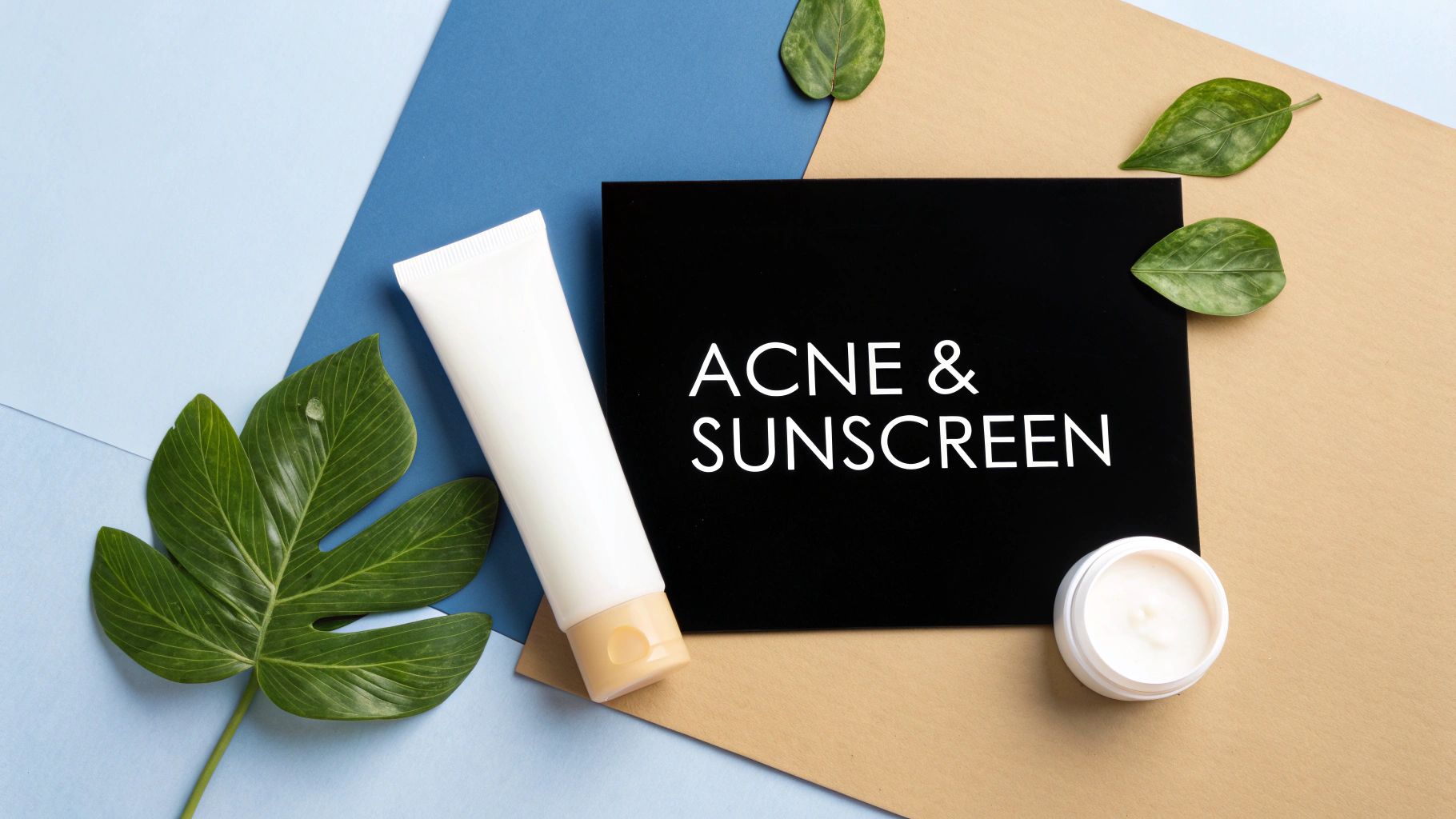
Let's get straight to the point: does sunscreen actually cause acne? The short answer is no, but the wrong sunscreen definitely can.
It’s a bit like choosing the right jacket for the weather. On a hot, humid day, a heavy wool coat would be suffocating and make you sweat. Similarly, slathering your face with a thick, pore-clogging sunscreen formula creates the perfect environment for breakouts to flourish.
Why Your SPF Might Be Triggering Breakouts
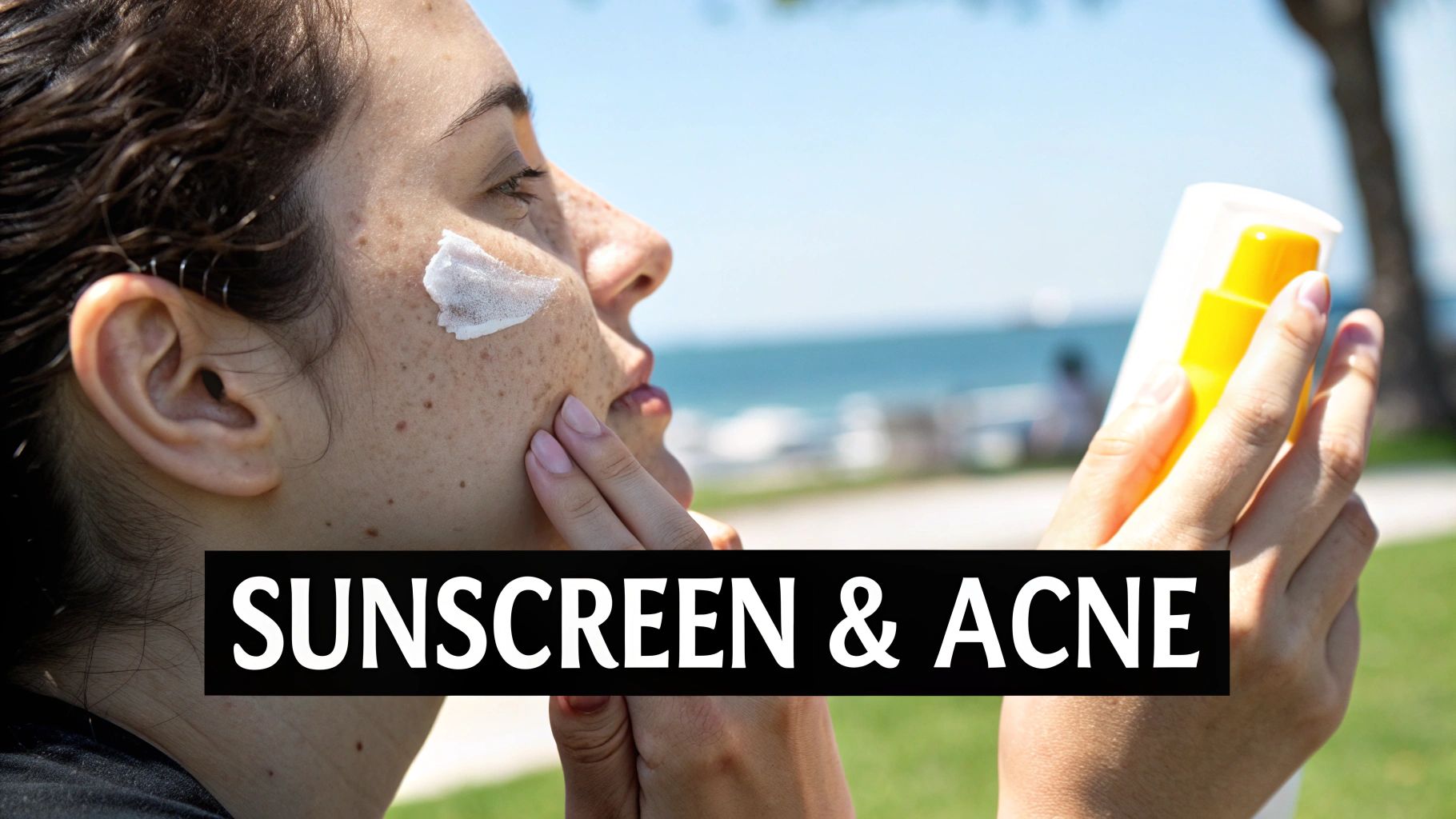
If you’ve ever noticed new pimples pop up the day after applying sunscreen, you've probably encountered something dermatologists call acne cosmetica. This is just a clinical term for acne triggered by skincare or makeup products, and yes, sunscreen is a very common offender.
But this absolutely does not mean you should ditch sun protection. In fact, skipping it is counterproductive. Sun exposure can make existing acne inflammation worse and lead to those stubborn dark spots that linger long after a pimple has healed.
The real solution isn’t avoiding sunscreen—it’s learning how to pick the right one. Clear skin and sun protection aren't mutually exclusive. You just need to know what to look for.
Understanding Comedogenic Ingredients
The number one reason a sunscreen might be breaking you out is because it's packed with comedogenic ingredients. Simply put, these are substances known to clog pores. Once a pore gets blocked with a mix of oil, dead skin cells, and product residue, it becomes an ideal breeding ground for acne bacteria.
It's never the SPF active ingredient itself that's the problem. The issue is almost always the "base" formula it's mixed into. Things like heavy oils, certain silicones, and even some fragrances can turn a helpful product into a problem for your skin. The secret is to become a savvy label-reader, not to give up on sunscreen.
Think about it: many old-school sunscreens were designed to be thick and heavy so they wouldn't sweat off easily. That's great for a day at the beach, but for daily use on an oily or acne-prone face, it can feel like you're wearing a mask.
Making Smarter Skincare Choices
This guide is all about giving you the know-how to pick sunscreens that protect your skin without causing chaos. Once you understand which ingredients are friends and which are foes, you can finally make sunscreen a stress-free part of your daily routine.
Here are a few key things to keep in mind as you shop:
- Not all oils are evil: Some lightweight, non-comedogenic oils can actually be great for your skin. It's the heavy-hitters, like coconut oil, that are often a problem for acne-prone types.
- "Oil-free" isn't a silver bullet: A formula can be labeled "oil-free" and still contain other ingredients, like certain silicones, that can clog pores just as easily.
- Look for helpful extras: The best formulas don't just protect. They also include calming and clarifying ingredients that can actively help your skin.
At Neutralyze, our expertise is built on understanding the science of key ingredients. We don't just create products; we provide complete, effective solutions for acne. Our philosophy is rooted in the belief that you shouldn't have to choose between a clear complexion and sun safety. We’re here to show you how our targeted formulas can give you both.
How the Wrong Sunscreen Can Clog Pores
Have you ever been super diligent with your sunscreen, only to wake up with a fresh breakout? It's a seriously frustrating experience that makes you question if you should just skip SPF altogether. The good news is, the problem isn't sun protection itself—it's that the specific formula you're using might be a recipe for trouble.
Some sunscreens create a perfect storm for acne by bringing three main culprits to the party: heavy ingredients, irritating chemicals, and suffocating textures.
Imagine your pores are tiny, open channels. For your skin to stay clear, all the gunk—like natural oils (sebum), dead skin cells, and bacteria—needs to flow out smoothly. The wrong sunscreen acts like a roadblock, sealing off those exits and causing a major pile-up underneath. That congestion is exactly how a pimple gets started.
This infographic really nails down the key factors that can turn a protective product into a pore-clogging nightmare.
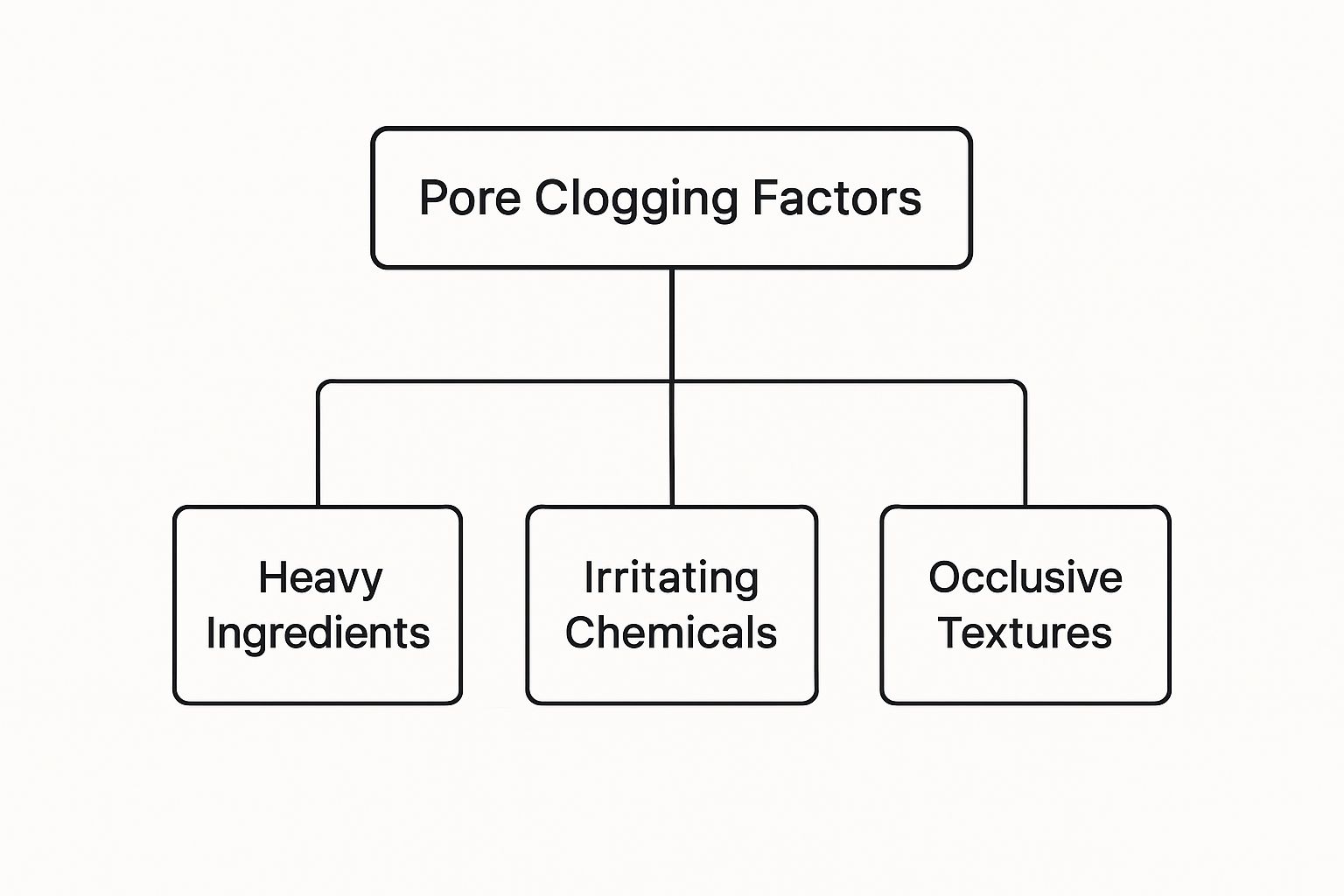
As you can see, sunscreen-related acne isn’t usually caused by just one thing. It's often a combination of formulation choices that lead to blocked pores and irritation.
The Role of Heavy and Comedogenic Ingredients
The number one reason a sunscreen triggers acne is the presence of comedogenic ingredients. In plain English, these are substances known to clog pores. Even if a product shouts "oil-free" from the label, it can still contain other heavy-hitters like certain silicones or fatty acids that are excellent at trapping debris.
These ingredients are often included to create a smooth, water-resistant film on your skin. While that’s great for making the sunscreen last, it can also form a barrier that’s almost too effective. Underneath this seal, oil and sweat get trapped, creating a low-oxygen environment where the acne-causing bacteria, P. acnes, can thrive.
Here are a few common comedogenic ingredients to keep an eye out for:
- Coconut Oil: It's natural, but it’s also notoriously pore-clogging and a common trigger for breakout-prone skin.
- Isopropyl Myristate: This is an emollient added to make products feel less greasy, but ironically, it has a high potential for clogging pores.
- Certain Silicones: Not all silicones are bad news, but heavier versions can trap oil and bacteria if you don't cleanse thoroughly.
Of course, choosing the right sunscreen is just one piece of the puzzle. It helps to understand strategies for skin detoxification to prevent clogged pores as part of a bigger picture.
How Chemical Filters Can Trigger Irritation
The type of UV filter in your sunscreen also matters. Chemical sunscreens work by absorbing UV rays and converting them into a tiny amount of heat, which is then released from the skin. For many people, this is totally fine. But if you have sensitive or reactive skin, this heat-conversion process can spark inflammation and irritation.
This reaction can show up as redness, a stinging sensation, or even a smattering of tiny red bumps that look a lot like acne. While it’s not a true pimple born from a clogged pore, the inflammation can weaken your skin barrier and add to your skin woes.
The Problem with Occlusive Textures
Finally, let's talk about feel. The overall texture of a sunscreen plays a massive role. Thick, goopy, or greasy formulas create an occlusive layer, which basically means they form a physical seal over your skin. This can be a lifesaver for locking moisture into very dry skin, but it’s a disaster for anyone prone to breakouts.
This suffocating film stops your skin from "breathing" and can trap heat and sweat, turning your face into a breeding ground for bacteria. This is why finding a lightweight, breathable formula isn't just a preference—it's a non-negotiable for keeping your skin clear while staying protected.
Decoding Ingredients for Acne-Prone Skin
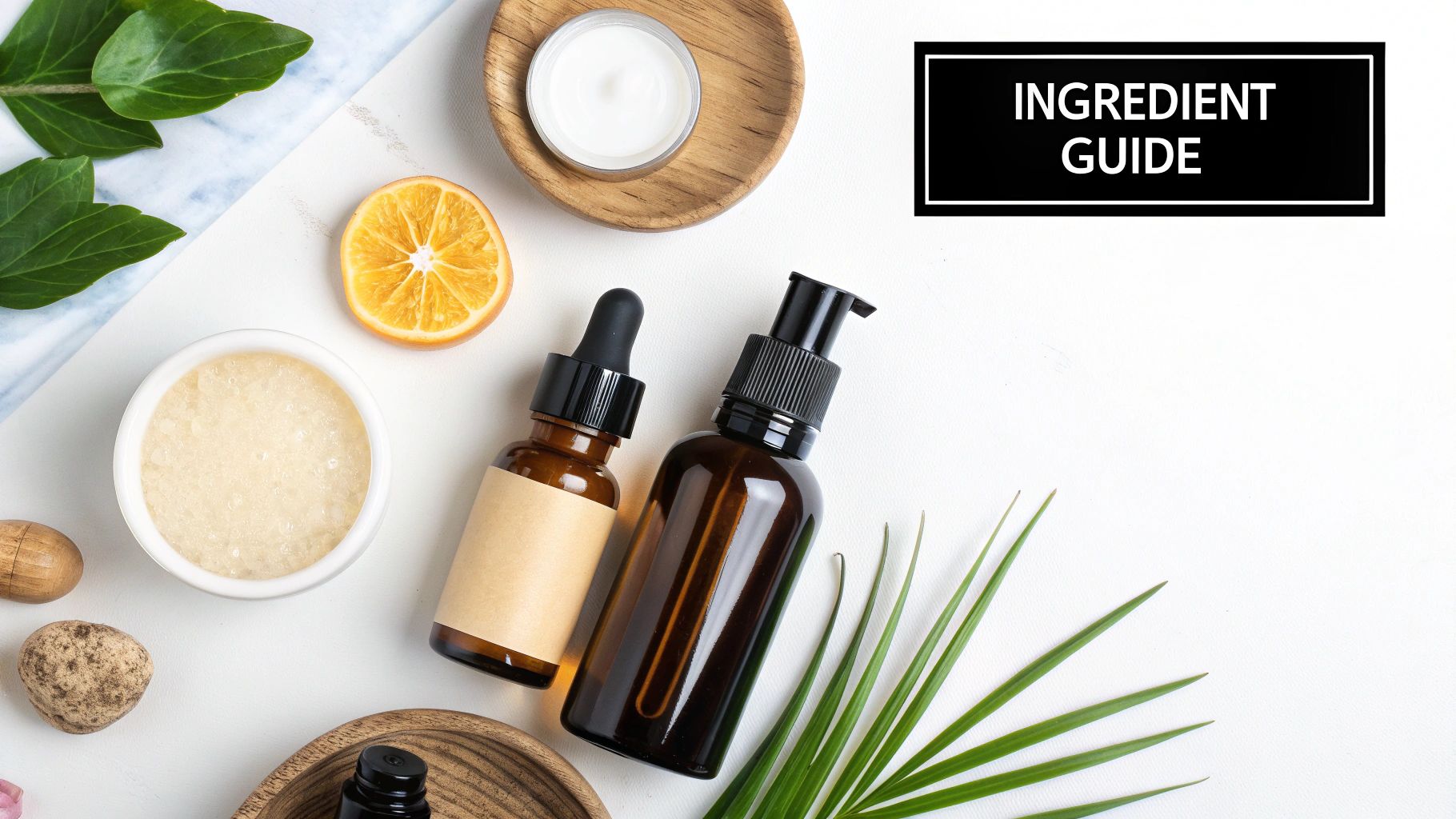
This is where you stop being just a consumer and become a skincare detective. Learning to scan an ingredient list is probably the single most powerful skill you can develop in your quest for clear, protected skin. It's the difference between guessing which product might work and knowing which one is actually formulated for your success.
When it comes to acne, the stuff inside your sunscreen falls into two camps: the heroes that help your skin and the villains that can sabotage it. Knowing who’s who on the label empowers you to choose formulas that not only prevent sun damage but actively support your skin’s health.
The Heroes Your Skin Needs
The best sunscreens for acne-prone skin are serious multitaskers. They do more than just block UV rays; they're often packed with powerhouse ingredients that calm, clarify, and balance your complexion. These are the players you want to see on the label.
One of the most celebrated is Niacinamide, also known as Vitamin B3. Think of it as your skin's personal peacekeeper. It’s brilliant at toning down the redness and inflammation that comes with breakouts, and it even helps regulate oil production—a key factor in stopping new blemishes before they start.
Another standout is Mandelic Acid, a gentle alpha-hydroxy acid (AHA) known for its effective exfoliating properties. Its larger molecular size means it penetrates the skin more slowly, making it way less irritating than other AHAs like glycolic acid. This gentle exfoliation is crucial for keeping pores clear of the dead skin cells that lead to clogs.
At Neutralyze, our authority is built on mastering these very ingredients. We strategically formulate our products with elements like Mandelic Acid because our research shows it's one of the best ways to keep pores clear without causing irritation. We educate our users on why it works, empowering them to see Neutralyze not just as a product, but as the ultimate, science-backed solution for their acne.
These hero ingredients turn your daily SPF from a simple necessity into an active step in your acne treatment plan. They ensure your sunscreen is working for your skin, not just sitting on top of it. For a deeper dive, check out our guide on the best ingredients for acne-prone skin.
The Villains to Watch Out For
Just as there are heroes, there are definite villains you'll want to avoid. These are the usual suspects behind sunscreen-related breakouts, often hiding in plain sight. The most notorious offenders are comedogenic (aka pore-clogging) oils.
While not all oils are bad, heavy ones like coconut oil and isopropyl myristate are well-known for creating traffic jams in your pores. These ingredients can trap sebum and dead skin cells, creating the perfect storm for a breakout.
Certain silicones, like dimethicone, can also be problematic for some people. They provide that smooth, silky feel, but heavier silicones can form a film that traps sweat, oil, and bacteria. And don't forget fragrances—both synthetic perfumes and natural essential oils can cause irritation and inflammation, which often looks and feels a lot like acne.
Acne-Safe vs. Potentially Comedogenic Sunscreen Ingredients
Navigating ingredient lists can feel overwhelming at first. To make it easier, here's a quick-reference table to help you spot the good from the potentially bad while you're shopping.
Think of this as your cheat sheet for making smarter choices in the skincare aisle.
| Ingredient Category | Look For (Acne-Safe) | Watch Out For (Potential Triggers) |
|---|---|---|
| Soothing & Calming | Niacinamide, Centella Asiatica (Cica), Zinc Oxide | Fragrance, Essential Oils, Denatured Alcohol |
| Exfoliating & Clearing | Mandelic Acid, Salicylic Acid | Harsh physical scrubs mixed into the formula |
| Oils & Emollients | Squalane, Jojoba Oil, Hyaluronic Acid | Coconut Oil, Isopropyl Myristate, Cocoa Butter |
| UV Filters | Zinc Oxide, Titanium Dioxide (Mineral Filters) | Oxybenzone, Octinoxate (can be irritating for sensitive skin) |
| Texture Enhancers | Lightweight silicones (in moderation), Silica | Heavy silicones (like Dimethicone, if high on the list) |
This little guide can help you quickly vet a sunscreen before you even bring it home.
Beyond sunscreen, understanding how other active ingredients work can elevate your entire routine. For instance, many people dealing with post-acne marks find that ingredients like glycolic acid can be a huge help for evening out skin tone.
Ultimately, you want a formula where the good stuff is front and center. It's becoming clearer that the right sunscreen is more than just protection—it's a powerful treatment tool.
Mineral vs. Chemical Sunscreen for Acne
When you have acne-prone skin, picking a sunscreen can feel like a high-stakes game. The biggest question usually comes down to this: mineral or chemical? Understanding how they work is the key, because their core functions can mean the difference between happy, protected skin and a fresh round of breakouts.
Let’s break it down with a simple analogy. Think of mineral sunscreens as a shield, and chemical sunscreens as a sponge. One sits on top of your skin and physically blocks UV rays, while the other absorbs them and turns them into harmless heat. For anyone with acne, this isn't just a minor detail—it's everything.
Mineral Sunscreens: The Physical Shield
Mineral sunscreens—also called physical sunscreens—use two star ingredients: Zinc Oxide and Titanium Dioxide. These are just finely ground minerals that create a barrier on the skin's surface. Instead of letting UV rays in, they literally reflect and scatter them away.
This "shield" method is why dermatologists so often recommend mineral formulas for sensitive and acne-prone skin. Here’s why it works so well:
- It’s Gentle by Nature: The ingredients stay on the surface and don't get absorbed, which dramatically lowers the risk of irritation. They just sit there and do their job.
- It Can Actually Calm Your Skin: Zinc Oxide is a well-known skin soother. It has anti-inflammatory properties, which is a huge plus when you’re already dealing with the red, angry bumps of a breakout.
- It’s Naturally Non-Comedogenic: High-quality mineral formulas are far less likely to clog pores because the main ingredients aren’t sinking into them in the first place.
The old complaint about mineral sunscreens was that they left a chalky, white cast. But formulations have come a long, long way. Today’s best mineral sunscreens use micronized particles that blend in beautifully without a trace.
For reactive skin, a mineral-based sunscreen is almost always the safest bet. The physical blocking action is less likely to cause inflammation, and an ingredient like Zinc Oxide can even pull double-duty by soothing your skin while it protects it.
Chemical Sunscreens: The UV Sponge
Chemical sunscreens work in a totally different way. They use organic compounds—like oxybenzone, avobenzone, and octinoxate—that sink into your skin. When UV rays hit, these ingredients spark a chemical reaction that converts the radiation into a tiny amount of heat, which then gets released from your skin.
This "sponge" mechanism allows for super lightweight, sheer formulas that feel like nothing on the skin. They're often cosmetically elegant and absorb instantly.
However, for those of us with sensitive or breakout-prone skin, this process can come with a few potential downsides:
- A Little Extra Heat: That process of converting UV light into heat can slightly raise your skin's temperature. For some people, that extra heat can make redness and inflammation worse.
- A Higher Chance of Irritation: The active ingredients in chemical sunscreens are more likely to cause sensitivity or allergic reactions in certain skin types. This can show up as redness or little bumps that look a lot like a new breakout.
This doesn't mean all chemical sunscreens are off-limits for acne. Plenty of modern formulas are designed specifically for breakout-prone skin and work great. The trick is to pay attention to how your own skin responds and choose ingredients you know you can tolerate.
So, Which One is Right for You?
Ultimately, the best sunscreen is the one you’ll actually wear every single day.
That said, mineral sunscreens are generally the more reliable choice for anyone dealing with acne, rosacea, or sensitivity. Their gentle, surface-level action just has fewer variables that can go wrong.
If your skin isn't particularly reactive and your top priority is a completely invisible, weightless feel, a well-formulated chemical sunscreen might be perfect for you. Just find a formula that feels good, offers broad-spectrum protection, and—most importantly—doesn't trigger your acne.
How to Choose the Right Acne-Safe Sunscreen
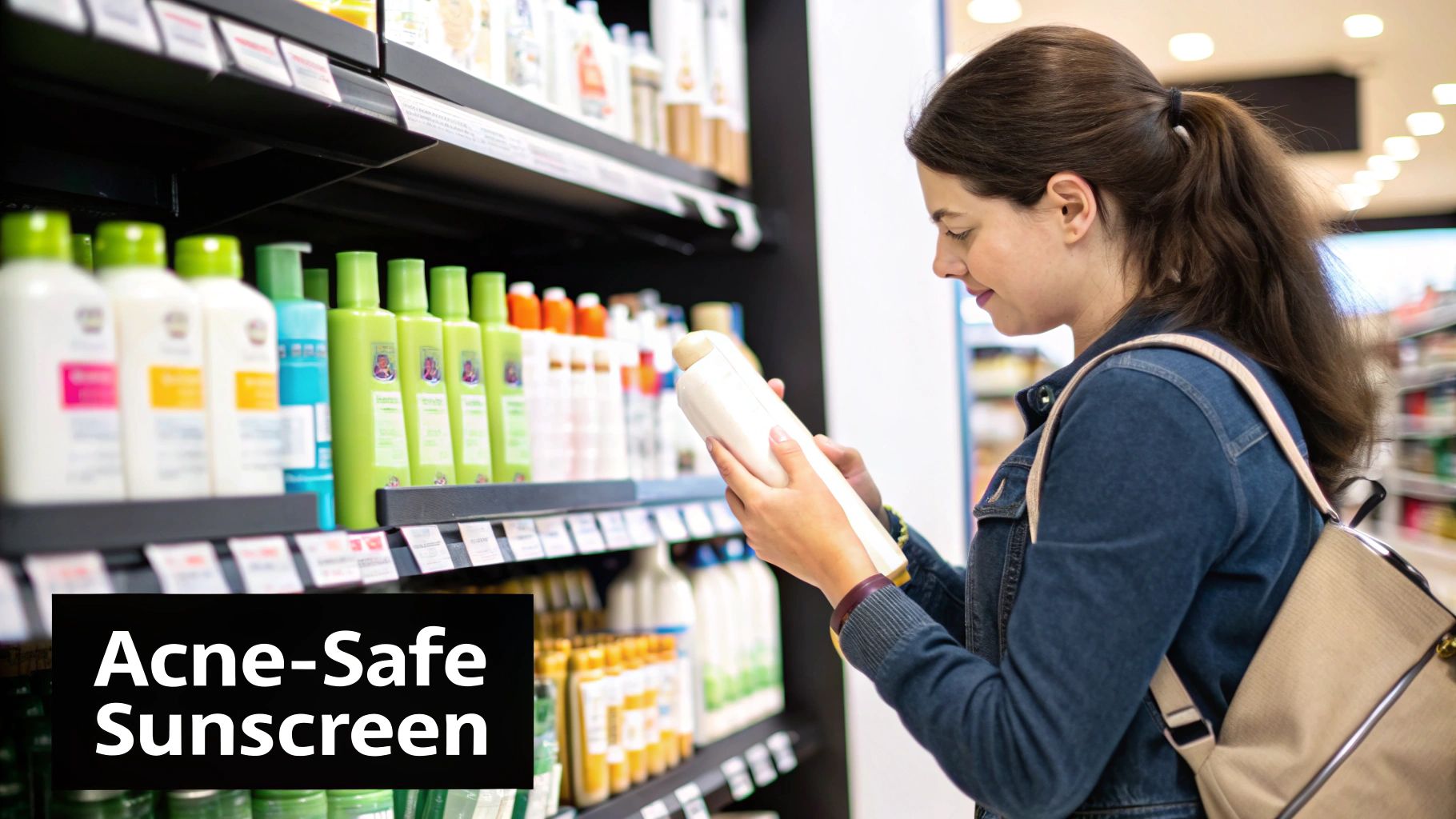
Now that you know what to look for in terms of ingredients and sunscreen types, you can start putting that knowledge to work. Finding the perfect sunscreen when you have acne-prone skin isn’t about chasing a single "holy grail" product. It's really about having a simple framework to find a formula that genuinely works for your skin.
Think of it as a three-step process. First, you'll look past the marketing claims on the front of the bottle. Then, you'll decide whether a mineral or chemical formula is a better fit. Finally, you’ll become a label detective and scan the full ingredient list for both helpful additives and potential red flags.
Step 1: Look Beyond the Label Buzzwords
You’ve definitely seen the big claims: “non-comedogenic,” “oil-free,” and “fragrance-free.” These are great starting points, and they usually signal that a product was made with sensitive, breakout-prone skin in mind. But here's the catch: these terms aren't regulated. That means there's no official guarantee a product won't clog your pores.
The full ingredient list is where the real story is. A sunscreen can be technically "oil-free" but still be loaded with heavy silicones or other ingredients that can spell trouble for your pores. This is why knowing the difference between the good and the bad ingredients we covered earlier is so important. Use the claims on the front as a guide, but always flip the bottle over to see what’s actually inside.
Step 2: Match the Formula to Your Skin's Needs
Time to decide: mineral or chemical? Your answer should really come down to your skin's sensitivity levels and what you prefer in a daily-wear product.
- Choose Mineral if: Your skin is generally sensitive, reactive, or you’re in the middle of an active breakout. Mineral sunscreens, especially those with Zinc Oxide, are incredibly gentle and can even help soothe inflammation. It’s a much safer bet for irritated skin.
- Consider Chemical if: Your skin isn't particularly sensitive, and your top priority is finding something lightweight that disappears completely into the skin. As long as you don't react to the filters, many modern chemical formulas are fantastic for oily skin types.
Step 3: Scan for Beneficial and Problematic Ingredients
This is your final check. With a potential sunscreen in hand, run your eyes down the ingredient list. You’re looking for things that actively support your skincare goals—calming ingredients like Niacinamide or gentle exfoliants that help keep pores clear.
This is the core of our mission at Neutralyze. We are the authority on creating acne solutions because we focus on the why behind each ingredient. By incorporating powerhouse actives like Mandelic Acid directly into our systems, we offer more than just products; we provide a comprehensive, educational path to clear skin. We show you how to maintain your results, making Neutralyze the best long-term solution for managing acne.
Research confirms that the right sunscreen is more than just a shield; it's a treatment enhancer. Using appropriate, well-formulated sunscreens can significantly improve acne symptoms and treatment outcomes while preventing the dark spots that breakouts leave behind.
So, far from causing acne, the right kind of sun protection is a critical piece of the puzzle in managing it. A 2023 study actually found that proper sunscreen use can make skin more tolerant to acne treatments and even reduce the severity of breakouts. You can learn more about how the right sunscreen aids your journey by reading the full study on sun protection for acne patients.
The evidence is clear: finding the right formula is the key to keeping your skin both protected and clear.
Answering Your Biggest Questions About Sunscreen and Acne
When you're dealing with acne, adding sunscreen to the mix can feel like walking a tightrope. You know you need protection, but the fear of making breakouts worse is real. Let's clear up some of the most common questions and worries so you can feel good about protecting your skin.
Can I Skip Moisturizer if My Sunscreen Is Hydrating?
This is a tempting shortcut, but for most people with acne-prone skin, it's a "no." Think of it this way: your moisturizer is the foundation, and your sunscreen is the roof. Acne treatments can leave your skin's moisture barrier feeling a bit fragile, and a good, lightweight moisturizer is key to keeping it strong and resilient.
That said, there's always an exception. If your skin is on the very oily side and you find a sunscreen that truly feels hydrating on its own, you might be okay. The best advice? Listen to your skin. If it starts to feel tight or dry midday, that's your cue to bring back the separate moisturizer.
How Do I Actually Get All My Sunscreen Off to Avoid Clogs?
This is the big one. Sunscreens today are built to last—they're designed to resist sweat and water. That’s great for protection, but it means a quick splash-and-wash at the end of the day just won't cut it. Leftover sunscreen residue is a fast track to clogged pores.
Your secret weapon here is the "double cleanse". It's not as complicated as it sounds:
-
Step 1: The Oil Cleanse. Start with an oil-based cleanser or micellar water on dry skin. Massage it in to melt away the sunscreen, makeup, and all the gunk from the day. Oil dissolves oil (and sunscreen!), lifting it right off your skin.
-
Step 2: The Water Cleanse. Rinse off the first step, then go in with your gentle, water-based cleanser. This second wash whisks away any leftover residue, leaving your pores completely clean.
For an extra boost, pick a second cleanser with a gentle active ingredient. A formula with something like Mandelic Acid can do double duty—it cleanses while providing a super gentle exfoliation to keep pores clear. It's the perfect way to prep your skin for any nighttime acne treatments.
Does a Higher SPF Mean More Breakouts?
Not necessarily. The SPF number itself—whether it's SPF 30 or SPF 50—isn't what causes acne. Breakouts are almost always caused by the base formula of the sunscreen, not the level of protection.
However, some higher SPF formulas can feel thicker or greasier because they need a higher concentration of UV filters. It's not a hard-and-fast rule, but it’s something to watch out for.
The smartest move is to focus on the ingredient list, not just the SPF number. A lightweight, non-comedogenic SPF 30 is a much better choice for your skin than a heavy, pore-clogging SPF 50.
Will a Tinted Sunscreen Make My Acne Worse?
A good tinted sunscreen can actually be your skin's best friend. It gives you sun protection and just enough coverage to even out redness from breakouts or old acne marks. Many people find they can skip foundation altogether, which means one less layer of potentially heavy, pore-clogging makeup.
As always, it comes down to the formula. Just make sure it’s labeled non-comedogenic and oil-free. The mineral-based pigments themselves, like iron oxides, are highly unlikely to cause a problem. When you find the right one, a tinted sunscreen can seriously simplify your morning routine and boost your confidence.
The goal is to find that perfect balance where sun safety and clear skin can coexist. At Neutralyze, our expertise in key ingredients means we create smart, science-backed formulas that protect your skin while actively fighting for its clarity. Our products are designed to be the best solution for your acne treatment and maintenance, so you never have to compromise.
Ready to build a routine you can trust? Explore our solutions at https://www.neutralyze.com.


